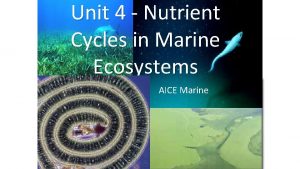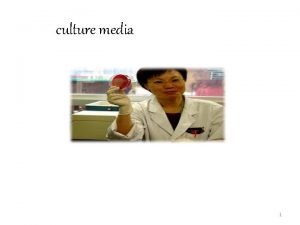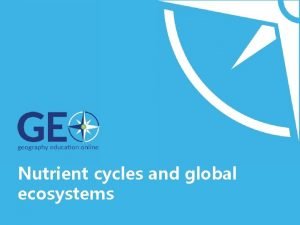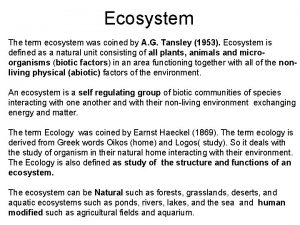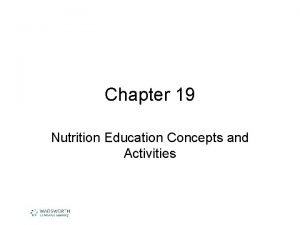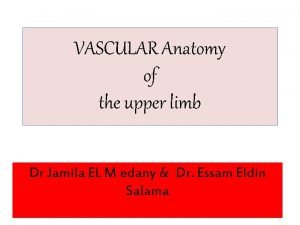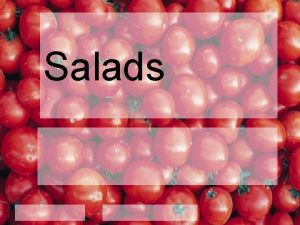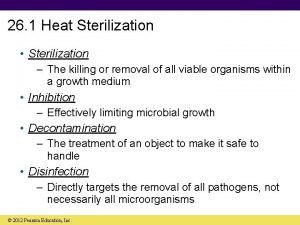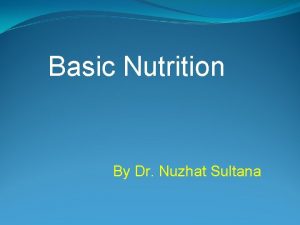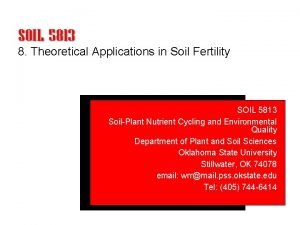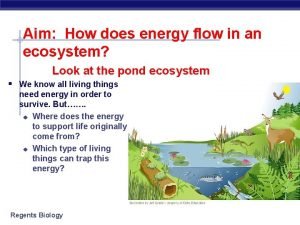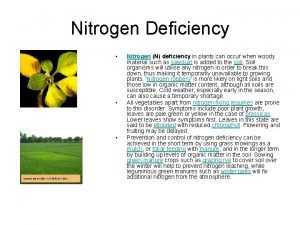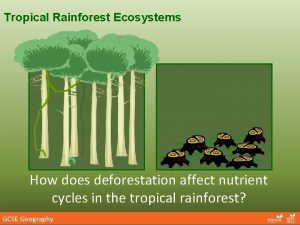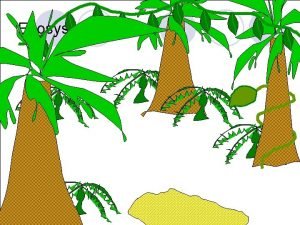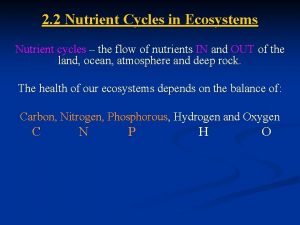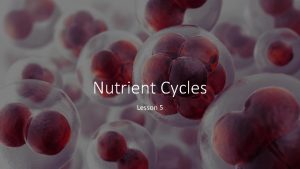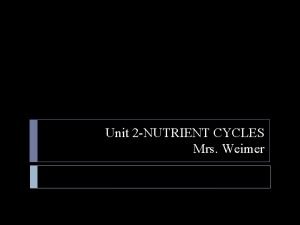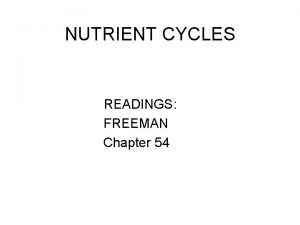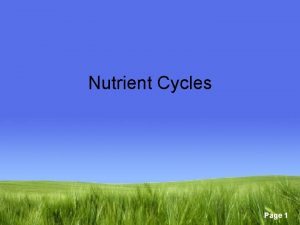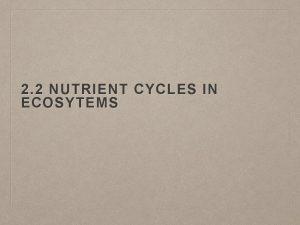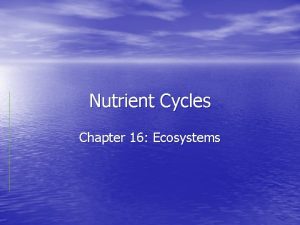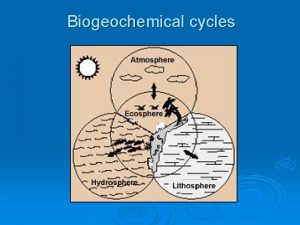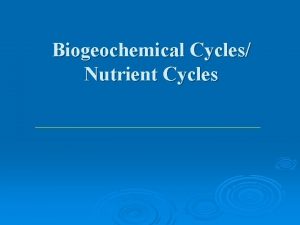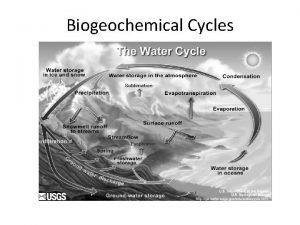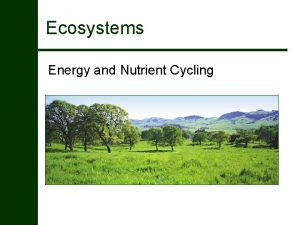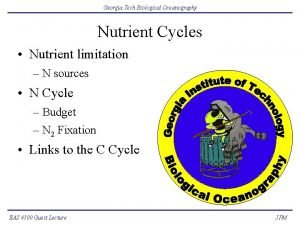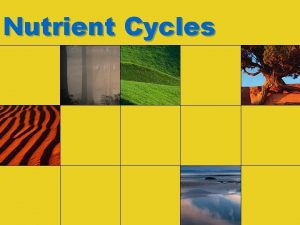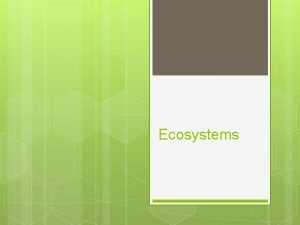2 2 Nutrient Cycles in Ecosystems Nutrient cycles

















- Slides: 17

2. 2 Nutrient Cycles in Ecosystems Nutrient cycles – the flow of nutrients IN and OUT of the land, ocean, atmosphere and deep rock. The health of our ecosystems depends on the balance of: Carbon, Nitrogen, Phosphorous, Hydrogen and Oxygen C N P H O


CARBON CYCLE A. Carbon Facts: • Carbon is found in all living matter. • Places that carbon is found are called stores or sinks Short-term Stores - living things in water & on land - rotting tissue of plants/animals - atmosphere (air) - ocean (dissolved in the water) Long-term Stores - underground (oil, gas, natural gas and coal) - sedimentary rock (limestone) - ocean floor (old shells)

B. How Carbon Changes Form: 1. Photosynthesis (in plants, algae and cyanobacteria) CO 2 + H 2 O + sunlight C 6 H 12 O 6 + O 2 2. Cellular respiration (in cells of all living things) C 6 H 12 O 6 + O 2 CO 2 + H 2 O + ENERGY (energy is used for growth, repair etc. ) 3. Decomposition (rotting) – done by bacteria/fungi cellulose CO 2

4. Ocean Processes: - Ocean mixing moves CO 2 around the world - CO 2 sinks in cold ocean waters flows to the warm equator and evaporates into the air. 5. Combustion: (burning, engines, volcanoes, forest fires) fossil fuels + O 2 CO 2 + H 2 O + ENERGY (oil, gas, natural gas, coal)


Human Activities & CO 2 1. Burning Fossil Fuels § § CO 2 in atmosphere has increased 30% in past 160 years. In the 160, 000 years before that, it only increased 1 -3%. Carbon is removed from long-term storage as we mine coal & drill for oil and gas. CO 2 is also a greenhouse gas (traps heat in atmosphere) 2. Removing Trees § § Trees absorb CO 2, so when they are cut down, CO 2 is released into the air. Other crops don’t remove as much CO 2

Nitrogen Cycle A. Nitrogen Facts § § § Makes up DNA & proteins Proteins are important for animal muscle function Nitrogen helps plants grow. Where Nitrogen is Found: § § Atmosphere (78% is N 2) Oceans Organic matter in soil Lakes, marshes, organisms

B. How Nitrogen Changes Form: - - N 2 is not usable by plants or animals, so it has to be converted to other forms. Plants can use NO 3 - (nitrate) and NH 4+ (ammonium) 1. Nitrogen Fixation • Lightning provides energy for N 2 (nitrogen gas) & O 2 NO 3 - (nitrate) & NH 4+ (ammonium) • Rain washes nitrate & ammonium into soil. (small amount) • Bacteria in soil (rhizobium) & cyanobacteria in water change N 2 (nitrogen gas) NH 4+ (ammonium). (larger amounts)

2. Nitrification (done by nitrifying bacteria). NH 4+ (ammonium) NO 2 - (nitrite) NO 3 - (nitrate) 3. Uptake • • Nitrogen compounds are sucked into plants & used for growth. Herbivores eat plants & use N for making proteins & DNA. 4. Denitrification (done by denitrifying bacteria & volcanic eruptions) • Converts nitrogen back to N 2 & returns it to the atmosphere

Nitrogen Cycle

C. Human activities affect the nitrogen cycle. The amount of nitrogen in the ecosystem has doubled in 50 y. due to: 1. Burning fossil fuels & sewage treatment. • NO & NO 2 are byproducts 2. Land-clearing by burning. • acid rain is formed which contains nitric acid (HNO 3). 3. Overfertilization • NH 4+ & NO 3 - leach into soil & waterways. • huge growth in aquatic algae = eutrophication • These algal blooms use up all CO 2 & O 2, block sunlight & produce neurotoxins which poison and kill many aquatic organisms.

The Phosphorous Cycle Phosphorous Facts • Phosphorous is a part of the molecule that carries energy in cells (ATP). • Phosphorous helps root growth, stem strength and seed production. • In animals, phosphorous is important for strong bones. Where Phosphorous is Found: • Not in atmosphere, but in phosphate rocks (PO 43–, HPO 42–, H 2 PO 4) and sediments on the ocean floor.

B. How Phosphorous Changes Form. 1. Weathering (breaking down rock into smaller pieces). a) Chemical weathering: acid rain or lichens releases phosphates (PO 43 - ) b) Physical weathering: wind, water and freezing release the phosphates. 2. Uptake: plants suck up PO 43 -, then are eaten by animals. 3. Decomposition: Bacteria break down organic matter & phosphorous is returned to soil. 4. Geologic Uplift: when rocks under the ground are pushed up weathering.

The Phosphorous Cycle

C. Human activities affect the Phosphorous Cycle. 1. Mining for fertilizer components: increases P in ecosystems quickly. 2. Slash-and-burn forest practices: reduces P turning it into ash, which runs into waterways.

How Changes in Nutrient Cycles Affect Biodiversity To Review: Any significant changes to any of these nutrients (C, H, O, N or P) can greatly impact biodiversity. 1. Carbon cycle changes climate change & global warming. 2. Too much nitrogen can allow certain plant species to outcompete other species. 3. Decreased levels of phosphorous slow growth of algae (important producers). Take the Section 2. 2 Quiz
 A terrestrial food web
A terrestrial food web Salmonella transport media
Salmonella transport media Biogeochemical cycles apes
Biogeochemical cycles apes Nutrient cycle in ecosystem
Nutrient cycle in ecosystem Ecology is coined by
Ecology is coined by Foods used in nutrition activities should be nutrient-dense
Foods used in nutrition activities should be nutrient-dense Are eggs nutrient dense
Are eggs nutrient dense Tamoxifen nutrient depletion
Tamoxifen nutrient depletion Dorsal arch veins
Dorsal arch veins Nutrient basics
Nutrient basics 4 main types of salads
4 main types of salads Nutrient agar plate
Nutrient agar plate Emulsifier in eggs
Emulsifier in eggs Balanced diet defination
Balanced diet defination Bray nutrient mobility concept
Bray nutrient mobility concept How does energy flow in an ecosystem
How does energy flow in an ecosystem Nutrient deficiency in tomatoes
Nutrient deficiency in tomatoes How does deforestation affect the nutrient cycle
How does deforestation affect the nutrient cycle
